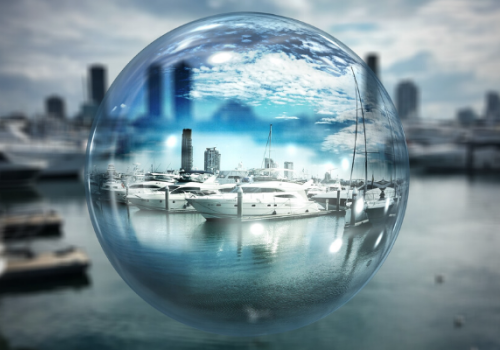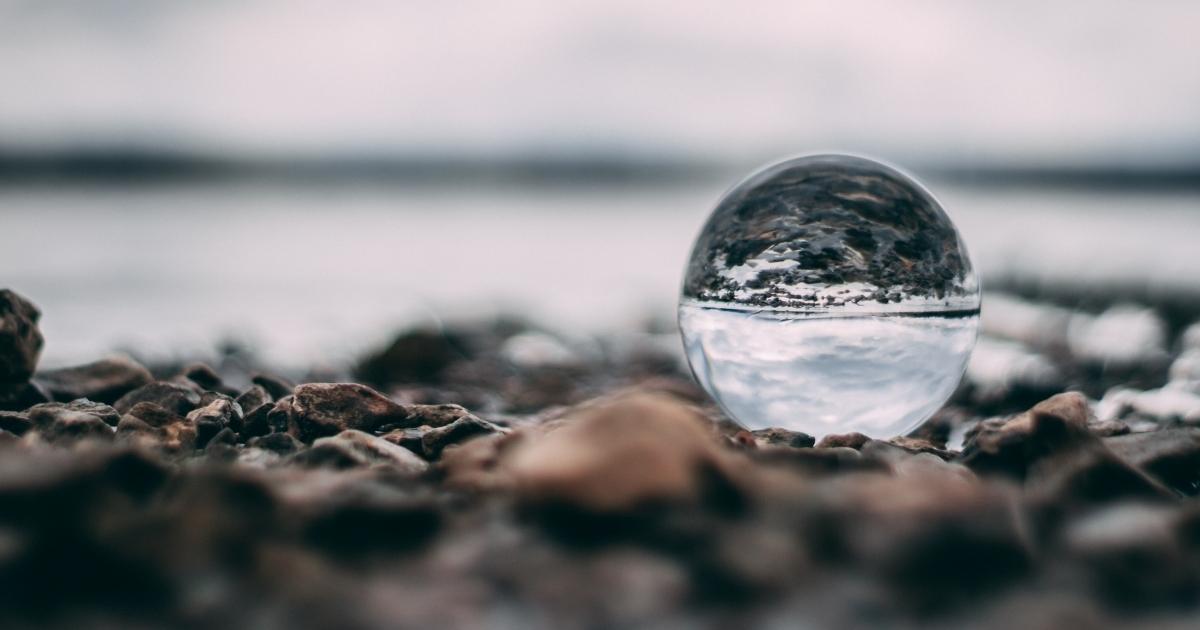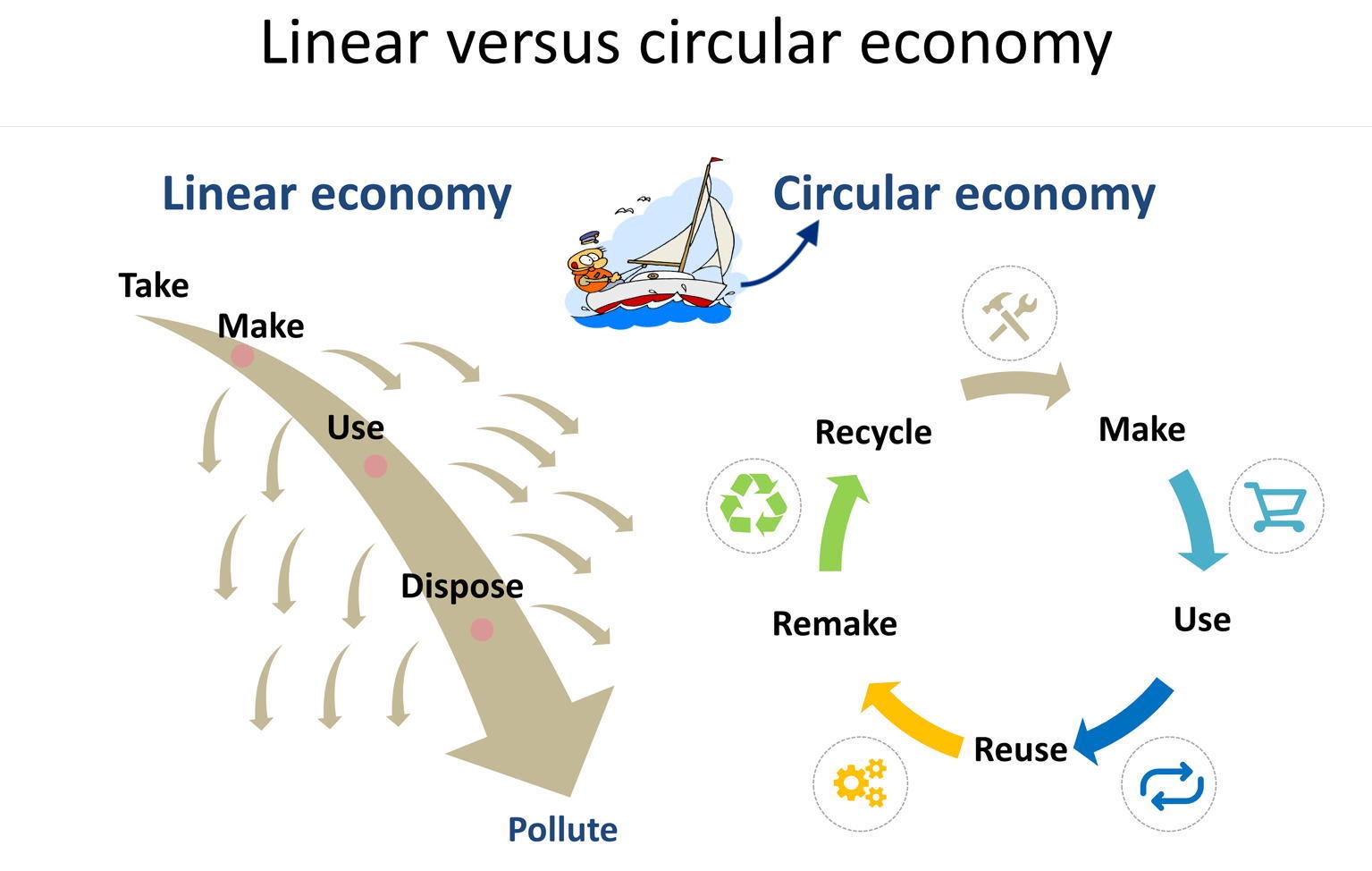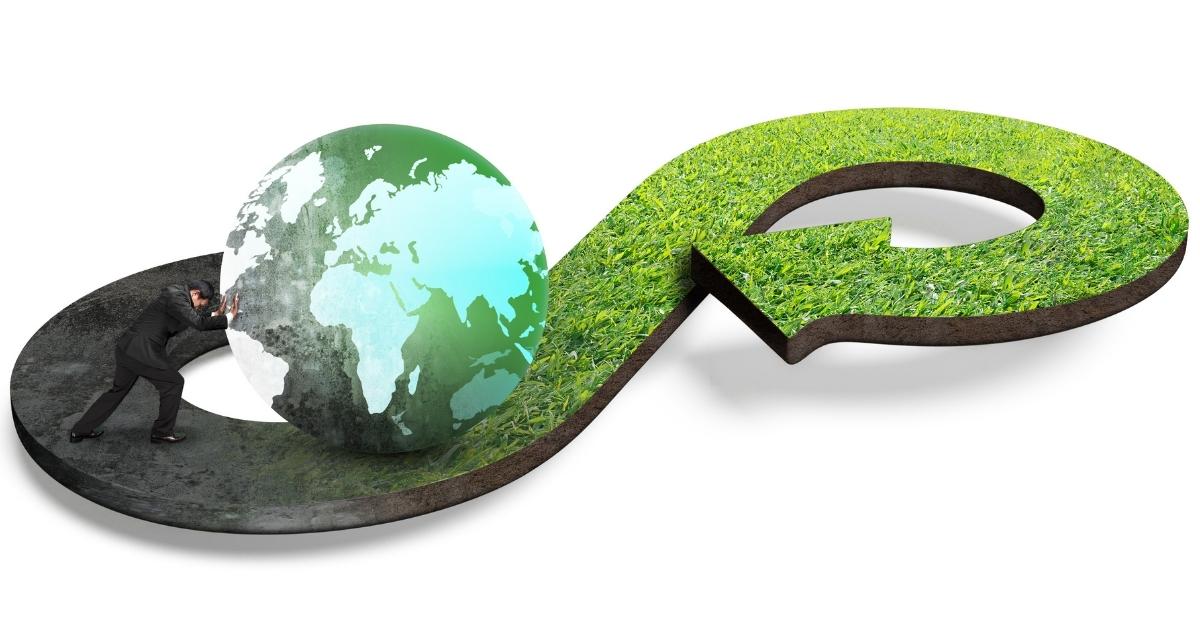Towards Circularisation in the Leisure Marine World

As some readers will know, for several years I have been helping to organise discussion forums around the subject of sustainability in the marine industry at the METSTRADE Marine Equipment Trade Show, which is held in Amsterdam every November.
This all kicked off in 2015 when, together with ICOMIA (International Confederation of Marine Industry Associations), we hosted a conference entitled ‘The Future of Yacht Recycling’. Our efforts were definitely not in vain because we have kept the subject in focus at subsequent shows, and each year we see more progress and more developing solutions - albeit not as fast as it should be, considering the ever-increasing number GRP boats reaching end-of-life without being disposed of in an environmentally responsible way.
More background details can be found here.
The following year we held another conference in Amsterdam entitled “Sustainability in the Marine Industry’. As well as focusing on the problem of how to deal with the heritage fleet of ‘dead boats’ again, we also dedicated more time to thinking about how to make the future of recreational boating more sustainable.
Quite clearly, when GRP boats came to the market and revolutionised the customer experience almost 70 years ago, nobody gave any thought to the long-term end-of-life consequences of building them from an almost indestructible material.
Surely, we reasoned, the boating world could not afford to continue with the linear take-make-use-dispose-waste concept which has led us to the scenario we now face: trying to find ways to eliminate the damaging outcomes for the environment to ensure the future sustainability of our industry.
These days we are all highly aware of the horrific damage to the environment from billions of single-use plastics and their end-of-life consequences on ocean life. This is probably the most high-profile illustration of what happens when we take the planet’s resources, make products from them and then just throw them away. These two closely-related themes are the concepts of Circular Economy and Life Cycle Assessment (LCA), and both have become an integral part of the general discussion around sustainability.
In order to emphasis this, I can’t do better than to quote the words of renowned naturalist and environmental campaigner David Attenborough: “We have a finite environment - the planet. Anyone who thinks that you can have infinite growth in a finite environment is either a madman or an economist.”
Now I’m sure that Attenborough was a little ‘tongue in cheek’ with his comments, and I guess even he would admit that many economists are also now seeing the financial benefits of adopting a circular economy as a win-win for consumers and businesses, as well as for the future of the planet.

Circular Economy explainers
One of the pioneers of the CE concept, and a person particularly relevant to our industry, is Dame Ellen MacArthur, who started her Circular Economy Foundation after circumnavigating the world single handed in 71 days. Since then, she and her team have been working to accelerate the transition away from the linear model by collaborating with business, academia, policymakers, and institutions to mobilise systems solutions at scale, globally.
The overall objective is to reverse the design thinking process that has previously stopped the moment a product reaches its end-of-life, and to engender a new business model which is underpinned by a transition to renewable energy and materials.
The CE concept is based on three principles driven by design:
1) Eliminate waste and pollution
2) Circulate products and materials at their highest value
3) Regenerate nature
In short, effectively decoupling economic activity from the consumption of the finite resources referred to by Sir David Attenborough.
One of the misconceptions around CE is that it involves some kind of sophisticated recycling process. However, the truth is, that recycling is still an end-of-life linear extension which basically continues the old overconsumption model. Recycling only starts at the throwing-away stage, and this is a process that is not made to preserve, increase or enhance the value of materials.
Of course, recycling has its place in the overall waste management strategy, but faced with our current environmental challenges, it's simply not possible for it to deal with the huge mountains of waste that the world is now producing. Therefore, the transition to a circular economy must be based on decisions made at the design stage, and this can determine around 80 per cent of the environmental impacts according to the Ellen MacArthur Foundation’s research data. Broadly speaking, this means that products and materials must be designed to be reused, repaired or remanufactured from their inception.
Circle Economy and the Circularity Gap
One of the inspiring speakers at the METSTRADE Sustainability Conference in 2016 was from the Amsterdam based Circle Economy, a not-for-profit organisation with a mission to empower a global community of businesses, cities and governments to accelerate the transition to the circular economy through practical and scalable insights and solutions.
Since then, Circle Economy has produced five yearly ‘Circularity Gap’ reports which serve to analyse and educate on how the CE concept is being adopted globally. The latest one published just recently includes a roadmap of 21 solutions that can be applied across all sectors and used by businesses, cities and nations. It claims that if applied globally and combined with the current climate pledges submitted by countries (Nationally Determined Contributions), the roadmap can reduce emissions by 22.8 billion tonnes and keep us on a 1.5-degree pathway by 2050.
However, the present situation presents a very large gap indeed, with a huge task ahead of us if we are to leap across it and evolve into a truly circular world. The latest report states that currently the world is only 8.6 per cent circular, because our take-make-waste economy consumes 100 billion tonnes of materials a year and wastes over 90 per cent.
To put this into perspective, in the six years between ‘COP25 in Paris’ in 2015 and ‘COP26 Glasgow’ in 2021, the global economy has consumed half a trillion tons of virgin materials, basically extracting 70 per cent more natural resources than what the earth can safely replenish!
Quite obviously this cannot continue - we only have one planet.
 Examples of circular economy concepts
Examples of circular economy concepts
The Circle Economy roadmap of 21 solutions literally covers every possible scenario in the living world from housing and construction, mobility, manufactured goods, nutrition, communication, to healthcare and education. Apart from housing it could be said that recreational boating fits into every one of these categories in one way or another.
Our industry must play its part in circularising the construction of leisure craft, and completely move away from the environmentally unacceptable end-of-life scenario which GRP composites have left us with. In recent years we are seeing more and more examples of how this can be done, including some that have been presented at METSTRADE.
A circular future for basalt fibres
A regular contributor to sustainability discussions at the show each year has been Enrico Benco, who started a business called Go Sailing For A Change, or GS4C for short, over ten years ago. Collaborating with a network of like-minded partners, Enrico has pioneered the use of sustainable ‘cradle to cradle’ composite materials using a basalt fibre called Filava, which is derived from volcanic rock. By combining this with a bio epoxy resin they have produced a material with equivalent mechanical and chemical properties to GRP. Most importantly, it has been independently verified that the composite elements can be separated and re-entered into the production cycle at the end-of-life.
GS4C have since entered production with a Mini 650, a sailboat that is 100 per cent sustainable and recyclable, designed to race single handed across the Atlantic in a race known as the Mini Transat.
They have also worked closely with Italian Superyacht builder Amer Yachts, who have embarked on a program to introduce the fully recyclable basalt composite into their future new builds.
Using the same ‘cradle to cradle’ basalt composite technology, an Ibiza based company called La Belle Verde has pioneered the market for a 100 per cent sustainable catamaran daysailer. Founded in 2014 by Dutchman Maarten Bernhardt, it was the island’s first and only emission free charter company offering eco-friendly solar/electric catamarans. Thankfully the hulls will not end up in landfill when they reach end-of-life but can be used to create the next generation of boats.
A circular future for flax fibres
Another innovative presenter at METSTRADE has been Friedrich Deimann, the founder of Greenboats, which has produced the Flax 27 Daysailer, constructed from a bio resin composite reinforced with flax fibres. These are taken from natural organically grown material, which is about half the weight of glass fibre, and is proven to be just as strong in independent tests. The flax composite consumes five times less energy to produce than GRP, is less harmful for the environment, and is easier to mechanically process for reuse at end-of-life.
At the superyacht end of the market, a similar flax based composite material has been adopted by Baltic Yachts, where they have used it for the interior panel work on the well-known Reichel Pugh designed Baltic 130, SY My Song. Since then, the yard has taken that development further, and is incorporating flax composites into 50 per cent of the structural mouldings on its Baltic 68 Café Racer, which has many outstanding sustainability credentials incorporated into its design.
A circular future for aluminium
Netherlands based Vaan Yachts, founded a few years ago by eco-entrepreneur Igor Kluin, is close to launching its first family size aluminium constructed sailing catamaran branded the R4. Igor set out to make sailing a more environmentally friendly and sustainable activity, so he chose to use a large percentage of certified recycled aluminium in the hull construction which comes from old window frames and road signs etc.
When the boat reaches end-of-life, the aluminium can be recycled and used again as a construction material. There is no limit on the number of times this can be done, and recycling saves 90 to 95 per cent of the energy that is needed to make virgin aluminium from bauxite ore.
Other circular features in the R4 catamaran include FSC certified cork decking, and leather-replacements from pineapple leaves and biological fabrics. The circular possibilities for the yacht’s end-of-life materials are so predictable that the company are able to offer a buy-back price after 25 or 30 years of use.
Another supporter of aluminium due to its circular possibilities is GreeNaval, a sustainable motor yacht builder based in Turkey. It is offering four models between 12 and 18 metres, and when the team designed the current series, they made the decision to move away from steel construction due to its weight, and to avoid GRP because of its poor end-of-life outcomes.
They point out, that an aluminium boat hull weighs about 30 per cent less than a comparable size steel vessel, and of course less weight means less energy for propulsion, thus resulting in reduced fuel costs and emissions over the lifetime of the boat.

A circular future for sharing
One of the much talked about aspects of the circular economy is the potential for developing sharing platforms, which means making better use of products by sharing them in order to make sure they are used more often, and by more people. Thus, getting a better return on the value of materials over their lifetime, and hopefully extending it.
Let’s face it, recreational boating probably has one of the most under-utilised products of all, with many family size boats laying idle in marinas for most of the year. That is not so common on larger yachts, particularly those that are regularly chartered. In these scenarios we do see the incentive to keep them well maintained and extend their life cycle for longer, which kind of proves the point.
However, the trend towards boat share or partial ownership schemes is clearly on the increase in recent years. A couple of strategic investments by major players in the leisure boating market are indicating that this growth in ‘flexible usage’ opposed to ‘ownership’ is very likely to continue.
Last year, Group Beneteau the market leading multi-brand boat builder made an investment of $40 million in charter, boat club and marina markets. Partnering with PPF, a private investment firm, it has acquired an 87 per cent interest in Dream Yacht Group, and a 50 per cent stake in Navigare Yachting. Between them, they have a fleet of over 1,200 boats which will facilitate access to boating via the sharing economy.
Beneteau has also taken a 40 per cent stake in US based 'Your Boat Club'. The company is poised for major expansion in the coming years with its network of 24 boat share clubs and seven marinas.
In a more recent announcement, major marine engine manufacturer Yanmar confirmed a $21 million investment to acquire a majority stake in ‘GetMyBoat’, said to be the world’s largest boat rental and water experience marketplace. With 150,000 varied types of watercraft available to rent online, and the possibility for boat owners to recoup on their under utilised investment, this is another sharing platform venture which is obviously seen by Yanmar as a growth market for the future.
With only 8.6 per cent of the global industrial economy currently being circularised according to the Circular Gap report, it’s probably fair to assume that the leisure marine sector is possibly a little below that figure. However, it is positive to see the entrepreneurial intent and creativity in the above examples, and I know for sure there are many more going on. In other words, it’s onwards and upwards towards a circular boating world, and no time to waste in getting there.
Images: supplied, Canva

Post your comment
You cannot post comments until you have logged in.
Login to post a commentComments
No one has commented on this page yet.
RSS feed for comments on this page | RSS feed for all comments